Robert Knox's Blog, page 22
April 5, 2018
National Poetry Month Day Four And (Working on It) Five: "Love, The Beloved Republic," and Something About a Field

Here's the prompt National Poetry Writing Month gave us for April 4, the fourth day of the creative ordeal offered this month to those seeking to write a new poem each day: Today, we challenge you to write a poem that is about something abstract – perhaps an ideal like “beauty” or “justice,” but which discusses or describes that abstraction in the form of relentlessly concrete nouns.... For example, you could have a poem about sadness that describes that emotion as “a rowboat tethered with fishing line to a willow that leans over a pond. Rainwater collects in the bottom, and mosquito eggs.” Concrete details like those can draw the reader in and let them imagine the real world where your abstract ideal or feeling happens.
I responded by borrowing a famous phrase from the Victorian poet A.C. Swinburne, who in a poem addressed to the Nordic earth goddess ("Hertha") catalogued all the wondrous gifts Earth was removing the notion of a creator God and bestowing in turn on humanity. Here's the part of Swinburne's poem where the phrase appears: But to you, as time takes him, This new thing it gives, Even love, the beloved Republic, that feeds upon freedom and lives.
Here's my poem for April 4:
4.4 Love, the Beloved Republic
All politics are personal The song sparrow hectoring a mate (Not tonight, dear, it's much too March) While hopping like an eighth grader in need of the men's room with pubescence on his mind,knows that Love is faithful as a mated pair: 'What happens in February, honey, stays in February You know you're the only beady-eyed, big-beaked, feather-bosomed Momma for me.' Love hops like a bower bird and sings in the spring.
Love endureth in the frowning countenance of Obstacle The flight of the butterfly speaks of love, steadfast in her journey Four generations later to the homestead of the heart And the whale sings across oceans a song of reunion to the distant pod, despite the separation of so many plankton-warm baths in the tropics, a feasting frenzy of microscopic kisses off the fish- friendly banks of British Columbia, Love connects through invisible networks, spume-spouted with photo attachments: 'That's me breaching and spouting off Yucatan Mex See you on the far side of the Marianna It's lovely this time of year in Antarctica'
Love keeps the stars in place, the planets connected Invisible hands fingered with zillions of subatomic digits, clasp in the embrace of astral Sein Und Zeit Love keeps the galactic market open for eons to come Remembers the dinosaurs fondly: sorry about that asteroid Love brings its lonely satellites home to Mater Terra The moon cycles endlessly, hoping to close for a kiss, noses brushing, risking the warmth of the final embrace willing to be singed in the clinch To burn, one ultimate moment, for Love
Love has many Followers, We wind its sacred bindings, unwrapped from the immortal dead
about our days, tie ourselves to its stakes Strike matches just to admire the beauty of the flame Rise from hallowed sleep to feast our senses upon the known geography of the Beloved, that terra connu, that unforsaken republic, the country of Love We pay our allegiance in souls coined from above
April 5: The prompt from National Poetry Writing Month for April 5 is truly a test. ('Always,' they remind you, 'optional'). Here it is:
Today, we’d like to challenge you to write a poem that reacts both to photography and to words in a language not your own. Begin with a photograph. Now find a poem in a language you don’t know. Now start translating the poem into English, with the idea that the poem is actually “about” your photograph. Use the look and feel of the words in the original to guide you along as you write, while trying to describe your photograph.
Here's the photo I chose.
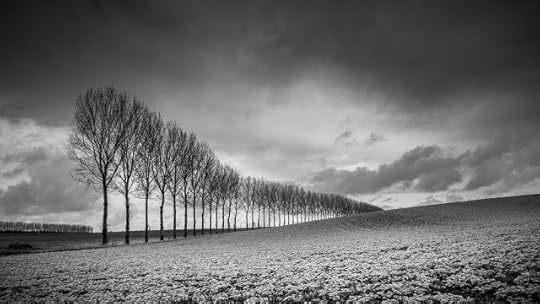
I found a poem from a suggested list written by a Belgian poet. The language, I believe, is Dutch. Suffice to say that I did not understand a word. So what follows can't realistically be called a "translation" when you can't read what you're supposedly rendering into English.... And the result, as the prompt assures us, is a "poem" that could not have been written any other way.
Nevertheless, I cobbled together some words:
4.5 The Rites of the Land The earth stands up, hands reaching for the rain, for water they need, those who drink from the bottom lands and those from the top, using what words they know. That which lives in the gift of self, that which stands apart on the stationary plane of rifts and stabbings blameless in the stirring life underneath the fires and the stars connects the right to grow and the words the angels speak. The meadow rolls where it will on the roundness of the land bluing the sky with the plume of rising words and slanting song. The grasses that grow in the strikes, the staffs of the archers, wake to the summons of the blinking sky -- and boiling mists -- resurgent in the dusk. They too drag land-dwellers into the remnants of the dance and the summons of the night, before even they can recall the names of their own.
For more about National Poetry Writing Month, here's the link:
http://www.napowrimo.net/
Published on April 05, 2018 20:39
April 4, 2018
April Is National Poetry Month. What We've Got So Far: A List of Crazy Art Shows, Surprising April News, and the Little Crocus That Could
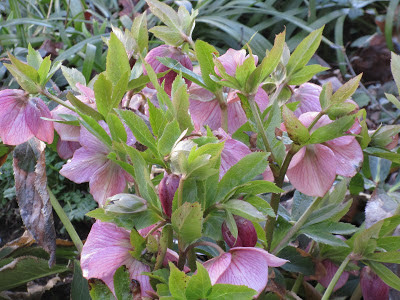 It's April! National Poetry Writing Month invites poets (a big-tent concept) to write a new poem each day. Here's what I've come up with so far, after getting a late start.
It's April! National Poetry Writing Month invites poets (a big-tent concept) to write a new poem each day. Here's what I've come up with so far, after getting a late start. My poem for April 3 follows from a prompt to write a "list poem" consisting entirely of invented names for new bands -- or, perhaps, romance novels, TV sitcoms, etc. Taking off from that concept I chose titles for new art installations.
4. 3 Brand New Art Installations: Accompanied By Lavish Illustrations (and chanted to the melody of "Durga Ma" by Edo&Jo)
The Garden of the New Broken Future O Zen, O Now Und Zen Green Hells Where the Hardhat Ants Raise Cities to the Sky The Garden of Fig Trees and Future Stress
Tiny Worlds Descending From Stories of Gods Clashing Airplane Views of Hidden Continents Roiled by Glacial Melting Octopussy Gardeners: Eight Little Garden-Gloved Hands Make Light Work of Spring Planting Beneath the Undiscovered Seas New Reefs Are Forming Inorganic Plastics and The Chain Migrations of the Sins of the Peculiarly Corrupt Cleansing Hate: Destroy the Photos and Plastic Figurines of Those Whom You Truly Detest Courtiers of the New Millennium, Who Wait with Trembling Knees, Bad Teeth, Phony Resumes, and Ignorant Diplomas Trapped Doors of the Anthropocene: Reptilian Teeth, Plastic Scales, Many-Legged Cretins The Bonsai of Recollected Vanities Hung by the Neck From Tiny Trees ... Coming to you at a nearby museum or gallery.
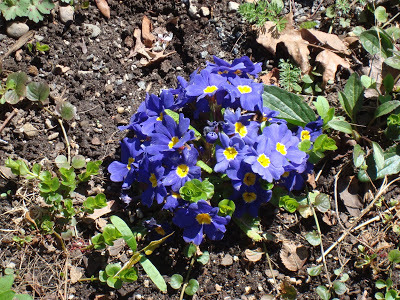 4/1/18: At Long Last April
4/1/18: At Long Last AprilWhat a heavy antidote April Fool's and Pesach, Easter on its wayI receive the doctor's note:I have Barrett's Esophagus todayI don't believe I know the manI really cannot say If he has lost a body partWe're all careless in our wayI can't imagine a reason why I'd stoop to scam used organsAnd if I were to finger fleshGod knows I'm no esopha-guyAdmiring a heart or lung Another stomach could be funA kidney for the one I lost I'd carefully consider cost I offered up a bladder galled And woke to find a world appalled My body gets up to such tricksI'm an open book -- with no appendix April, I'm not fooling here My body's growing hollowBut when I'm charged with organ theftIt's more than I can swallow.
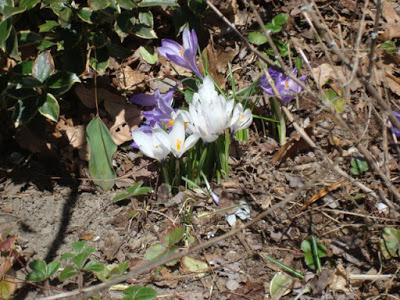
4.2.18 I See You, Croci, You See Me
i.
I see you peeping up there from a shelter of old leaves You really bring some color when and where we need it most You really are a hero, a guest who blossoms into host the little guy who lives to try and when they throw the garbage lid upon your tiny yellow id you flatten out like Hamlet did and your rating sinks to zero You're an emblem of our time A flag to welcome spring In a day or two you reach your prime And when your glory turns to dust It really is a crime.
ii. I see you peering down at me You boot-steps almost nearing me I wish you would be fearing me But I just don't have the time You think I'm just a show-off a sunny flash for your delight But I have my own agenda And I close up every night There's a plan for my expansion Seed money in the bank And if some day your garden fills with a host of golden daffodils You won't have me to thank But I lead the way for those to come, light the pathway to the sun So April boots must watch their step For though the season seems to creep It's we who make it run.
[for more about National Poetry Writing Month see http://www.napowrimo.net/2018/04/ ]
Published on April 04, 2018 20:56
April 3, 2018
The Garden of Verse: April Fools! -- Snow Falls, Spring Flowers Bloom, and Poets Dwell on Poetry
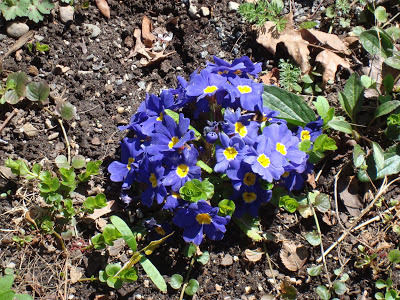 We are all fools for April.
We are all fools for April. This year when Easter Sunday fell on April First, April Fools Day surprisingly held off the snow until the second day of the month. Snow fell for the morning hours on April Second, filled the yards, clung to all the trees and shrubs, while the birds hid in the hedges waiting it out. Midday came, the snowfall stopped on a dime; its inch-or-two accumulation watered our earth and was gone in an hour. By the time Anne came home from work, the sun was shining, and she declared an official, though unexpected "beautiful day."
Here we are, April. Back to bright mornings followed by rainy afternoons -- or, perhaps, the opposite -- for who knows how long. Hopefully not for the full month's duration.
But this is April's regular menu. So take the good stuff when you can. And hope the weather doesn't save its worst tricks for your days off.
April is a tricksy month.
Verse-Virtual, the poetry journal I write for, pulled out another new trick this month, as editor Firestone Feignberg built a whole issue on poems 'about' poetry. That's both a hard thing to do and an easy one.
Sometimes poets fall into a trap of turning everything they write into a poem about poetry. Every description ends up saying something is "like a poem." If that's the 'easy' approach, it's also the wrong one.
Overcompensating, perhaps, I decided to limit my own field of composition to responses to poems, or other writings, that have in the past explicitly addressed the 'what' in the question 'what is poetry.'
The result is that the three poems I contributed to the April edition are all based on well-known texts: Archibald McLeish's oft-anthologized (and quoted from) "Ars Poetic." This is the poem that concludes with the famous line "A poem should not mean, but be."
Marian Moore's early 20th century poem "Poetry," that beings with the widely quoted line: "I too dislike it."
The third poem actually responds to critical writing (by Harold Bloom) on the idea of the poetic "daemon," the spirit of poetic inspiration, as applied to the poet Walt Whitman and other influential American writers. I'll post the beginning of that poem here:
Daemon Lover
("The daemon know how it's done" -- Harold Bloom)
The wandering ear hears
the daemon along the shore
in autumn's moan and breaks the chain of illusion
Everything happens in the past. No one can live in a present
that fires too quickly, like the pilot in the old stove
that keeps us alive but can't tell us what it means,
that passes too quickly, breathing through time's stuffed nostrils,
coughs once, maybe twice, then shakes us off
like a dog breaking the neck of something small and barely alive
The daemon breaks the necklace
of time...
Please find the end of this poem, my two others, and many other fine poems from Verse-Virtual's contributors in this month's issue.
Here's the link:
http://www.verse-virtual.com/robert-k...
Published on April 03, 2018 12:50
March 30, 2018
The Garden of Verse: My New Poetry Book "Cocktails in the Wild" Published in Time for Spring
 Welcome, spring! And welcome my new poetry book!
Welcome, spring! And welcome my new poetry book! My new poetry chapbook, titled "Cocktails in the Wild," was published on March 27 by Unsolicited Press and is available from their website at
http://www.unsolicitedpress.com/store... The 'cocktails' in the title refer to a poem about Lebanon called "Cocktails on the Balcony." and was inspired by visits to our daughter's home in Beirut, where in fact most of the 'cocktails' we enjoyed while happily idling on her lovely balcony consisted of various kinds of freshly squeezed orange juice. That poem begins: BeirutOne flag Three green peoples
and concludes:With Mediterranean View Drinks on you
The "wild" in "Cocktails in the Wild" refers to the content of many of these poems -- the grim seasons of the American 2016 presidential campaign; a squawking peaceable kingdom in Florida (watch out for the alligators); a misunderstanding in a phone call to India; a rant about the shortcomings of our "arthritic sclerotic idolized Constitution." Here's how one of my wilder rants on the state of American political culture, titled "Sacred Cowers," begins: American Shibboleths:the arthritic sclerotic idolized Constitution, the all too semi-sovereign states,the short-circuited electrical college, those doddering fools squatting on an ancient panel of archons supreme:Rule by anachronism
... And it goes on from there. Here's some of what the publisher said about my book:
COCKTAILS IN THE WILD explores poetic form wildly from couplets to long winding lines that swallow the reader up and transport them to a new place. A place for the senses. A place for the heart. Robert Knox toys with political and social conventions of today's modern landscape, and at the same time lets the reader revel in all of niceties of the natural world.
.... The poems take us from a balcony in Beirut, a place of beauty, history and danger, to the grim seasons of the American 2016 presidential campaign. We place a phone call to India, view a squawking peaceable kingdom in Florida (mind the alligators lurking below), raise a glass in homage to Keats and Philip Larkin, and remember that the way things were is not a recipe for tomorrow, but a gateway to today. Let's walk through it to the wildness in ourselves.
Publishers are expected to praise the books they choose to publish, but I still appreciate nice things said about my work. A chapbook is a half-sized poetry collection; this one is 21 poems in 50 pages. They're popular with publishers of poetry because their small size helps keep the publishing costs down. "Cocktails in the Wild" is my second chapbook within the last year. The first, published last May, titled "Gardeners Do It With Their Hands Dirty," was published by Finishing Line Press and is available from that press's website:https://www.finishinglinepress.com/pr...... or from me, by writing me at rc.knox2@gmail.com.
I do love spring -- and all that blooms. Happy Passover, and Happy Easter.
Published on March 30, 2018 10:19
March 22, 2018
The Garden of Verse: Poems Like Prayers in March's Verse-Virtual
 Poets have a wide of variety of uses for "prayer" -- the word and the concept. They don't necessarily pray 'for' something. They don't necessarily "recite" a prayer. And sometimes, as in the poems written on the theme of prayer for the March issue of Verse-Virtual.com, they make them up.
Poets have a wide of variety of uses for "prayer" -- the word and the concept. They don't necessarily pray 'for' something. They don't necessarily "recite" a prayer. And sometimes, as in the poems written on the theme of prayer for the March issue of Verse-Virtual.com, they make them up. In "Benediction" Wesley McNair writes his own prayer of blessing. The diction and image flow seamlessly in this poem about flowering plants (or 'nature,' 'the seasons,' or what Thoreau famously called "wildness"), exactly mirroring its subject. Those "lilies of the field" we are asked to consider may stop attracting our eyes when their flowers have passed, but they remain part of a pattern and a process that the poem aptly names as "the joy of everything":"Consider the lilies of the field,
how they grow
beyond their flowering, no longer
beautiful to our eyes. Consider
the brittle-petalled, black
centers of the black-eyed Susans,
waving like pom-poms
in the cold wind." Everything connects in this wonderful "Benediction."
Prayer often mixes with other occupations, as noted in the title of DeWitt Clinton's poem "ON LISTENING TO ITALIAN ARIAS WHILE STOPPING FOR COFFEE ON ROSH HASHANAH." Not such a stretch when you think about it. The lovers and dreamers of Italian opera often find themselves in desperate straits and turn to prayer for help, or at least comfort. The poem spreads its universalizing notion of prayer from opera singers to rocks, the sky, water, animals and finally to people trying to compose prayer. The final request, believably enough, is for more time.
In David Chorlton's poem "Night Trains," the rattle of trains passing along the track "click like rosary beads." In this tightly woven poem, the trains see everything ahead with "a single eye." Whether this excellent poem is a benediction or an inquisition -- "They take trees by the root/ and rattle their leaves" -- is up to us. Maybe both.
In Barbara Goldberg's "Flock," the familiar language of a religious text is put to new uses that evoke the sacredness of the everyday. "The Lord is my shepherd
He rides a red tractor
His work boots caked
With earth and dried dung" Words from sacred texts we are likely to hear over and over again can birth new poems, just as lines from Shakespeare or Frost do. Here the words of a psalm mix with images from the everyday, as the poems encompasses a real shepherd and his sheep, a "red tractor," "a black dog yapping/ to keep them in line," and some well cared for sheep who "do not want." The combination leads me to feel that the sacred is everywhere.
Sarah White's poem "God Creates Eve on a Prayerbook Page" extends the notion of prayer to include the medieval practice of "illuminating" the meaning of the text with often highly individualized visual depictions. The poem continues this fertile relationship by offering a vivid praise song to a curiously engaging illustration. It notes "God had clothes galore—
Crown, cloak, robe of illuminations blue,
beard, a bit like Charlemagne’s, aflower." While Adam, "wore nothing but his curled coiffure." At the end our banished first couple dream of "a place/ like a tapestry" -- with a loose string that "she" cannot help pulling. The poem is brilliant fun, capturing a lighter-hearted humanity in this ancient art.
The dog in Jefferson Carter's poem "Strep Throat" is indeed a loving dog. He is the answer to a sick man's prayers. The poem wittily ties together the speaker's remembrance of Che Guevara (who called apolitical friends "Drunks, singing, their throats/ about to be cut") and his own title malady, by depicting the devoted canine's entrance into the sufferer's bed "wriggling the comforter
aside & draping himself
over my head like
someone’s flung beret." A happy and satisfying image. < Marilyn Taylor's "Poem for a 75th birthday" is an implicit prayer of gratitude written in the language of love. She captures her husband, a gifted gardener, in this beautiful depiction: "it’s nearly evening
and here you still are, slow-dancing
in your garden, folding and unfolding
like an enormous grasshopper in the waning
sun."
This prayer of thanks then moves straight to a sort of theological certainty: "...I lean
in your direction, absolutely satisfied
that summer afternoon is all
there is, and night will never fall." I take away from this poem an image of a vision.
There's so much, as another contemporary lyric puts it, to be thankful for in these and the many other fine poems in Verse-Virtual's March 2018 issue. http://www.verse-virtual.com/poems-an...
--
Published on March 22, 2018 08:30
March 13, 2018
The Garden of Garden Styles: Or, the Japanese Do Florida


It was Sunday. The paths were crowded. It was Florida. People walked by in shorts, talking on their phones. Some groups chatted about other places, other
times.
But the Morikami Japanese Gardens are about being here now. Eventually we found the gardens within the garden. The website for the Morikami Museum (https://morikami.org/roji-en/) and Japanese Gardens tells us that the gardens are actually named "Roji-en: Garden of the Drops of Dew," and were designed Hoichi Kurisu in 2001 and inspired by (but not copies of) traditional garden styles. They were built on a large tract of donated land in the town of Delray Beach, by a colony of Japanese farmers who came there a century ago.
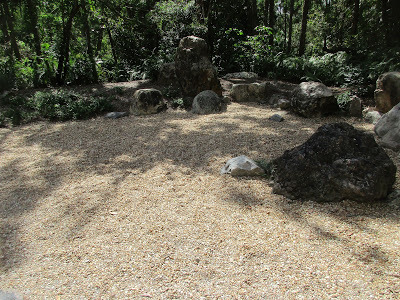 About a thousand years ago, the Morikami Museum website tells us, Japan's ruling upper class adopted Chinese garden design ideals featuring lakes and islands. Ideally these "gardens" were viewed from a boat, and classic wooden bridges were part of the design.
About a thousand years ago, the Morikami Museum website tells us, Japan's ruling upper class adopted Chinese garden design ideals featuring lakes and islands. Ideally these "gardens" were viewed from a boat, and classic wooden bridges were part of the design.
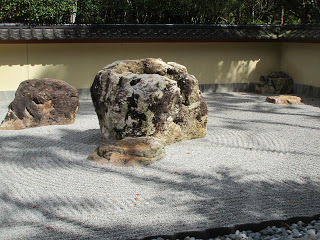 Today at Morikami, this is how you start the tour, walking across a traditional little foot bridge to take in the lake and a couple of islands, fringed with green and flowers beneath the reliably blue skies. (Sorry, no boats.)
Today at Morikami, this is how you start the tour, walking across a traditional little foot bridge to take in the lake and a couple of islands, fringed with green and flowers beneath the reliably blue skies. (Sorry, no boats.)
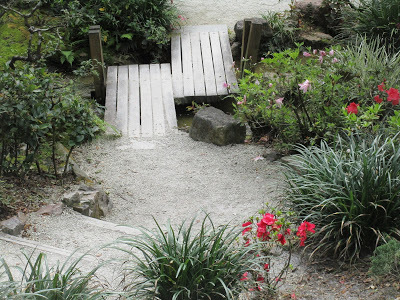 Anne and I then followed the path along the lake's circumference, enjoying the rich landscape of trees, flowering plants and frequent signed 'features' to look at (lake view, top photo). It takes me about half an hour to realize that the site's layout encompasses six distinct 'formal' gardens based on different styles, and periods, of the Japanese garden. Our circumambulation of the lake represents the oldest of these, the "Shinden-style" garden. The lake's two little islands, the website points out, "are reached by a stately arched bridge similar to those often painted vermilion in Japan after models originating in T’ang Dynasty China (618 – c. 907)." The second of the six "gardens" -- a very elastic term, as we should not be surprised to realize -- called "The Paradise Garden" features paths (instead of boat rides) for strolling the perimeter of the garden's lake. I cannot recall at what point we pass onto this path, though Anne recalls seeing a sign for "Paradise Garden." (Second photo down.) What I recall is that about halfway around the lake, a labyrinth of paths begin to twist around one another in a complex design dimensionally more intricate than, say, the NYC subway map. This style developed, the site tells us, from a troubled upper-class 12th century belief "in the western paradise, the Pure Land, here on earth." The Paradise Garden is intended to help you visualize this place from a path along the perimeter of the garden's lake: "Paths led from vantage point to vantage point from which changing scenery could be viewed."A lovely idea. Interestingly, these gardens were not built for the old "nobility," but for the men and women of the newly arisen samurai class whose "manner of attire," the website states, "allowed them greater freedom out-of-doors. Garden paths typically led to a pavilion overlooking the pond in which guests would gather to enjoy the recently imported fashion of drinking tea." The Paradise Garden strikes me as a good name for any place where you overlook water and contemplate a healing view, whether drinking tea or something stronger.
Anne and I then followed the path along the lake's circumference, enjoying the rich landscape of trees, flowering plants and frequent signed 'features' to look at (lake view, top photo). It takes me about half an hour to realize that the site's layout encompasses six distinct 'formal' gardens based on different styles, and periods, of the Japanese garden. Our circumambulation of the lake represents the oldest of these, the "Shinden-style" garden. The lake's two little islands, the website points out, "are reached by a stately arched bridge similar to those often painted vermilion in Japan after models originating in T’ang Dynasty China (618 – c. 907)." The second of the six "gardens" -- a very elastic term, as we should not be surprised to realize -- called "The Paradise Garden" features paths (instead of boat rides) for strolling the perimeter of the garden's lake. I cannot recall at what point we pass onto this path, though Anne recalls seeing a sign for "Paradise Garden." (Second photo down.) What I recall is that about halfway around the lake, a labyrinth of paths begin to twist around one another in a complex design dimensionally more intricate than, say, the NYC subway map. This style developed, the site tells us, from a troubled upper-class 12th century belief "in the western paradise, the Pure Land, here on earth." The Paradise Garden is intended to help you visualize this place from a path along the perimeter of the garden's lake: "Paths led from vantage point to vantage point from which changing scenery could be viewed."A lovely idea. Interestingly, these gardens were not built for the old "nobility," but for the men and women of the newly arisen samurai class whose "manner of attire," the website states, "allowed them greater freedom out-of-doors. Garden paths typically led to a pavilion overlooking the pond in which guests would gather to enjoy the recently imported fashion of drinking tea." The Paradise Garden strikes me as a good name for any place where you overlook water and contemplate a healing view, whether drinking tea or something stronger.
 The "Early Rock Garden" is a Zen garden, the only phrase I've ever associated with Japanese gardens. The new style was favored by the now dominant samurai class, drawn to Zen ideas of self-reliance and sacrifice. (I'm not sure that's the side of Zen that caught on in the West.) The most obvious innovation in this style is the replacement of water by rock (including sand or gravel; third photo down) meant to suggest waterfalls or watery surfaces. The website says, "Often such gardens were in imitation, not of nature directly, but of landscape ink paintings in the Southern Sung style... spare, devoid of color, suggestive of a cogent inner truth." We've always taken Zen gardens as places designed for meditation. That seems pretty close to the idea. The "Late Karesansui Garden" is also a rock garden, now almost completely devoid of plants, consisting of flat expanses "of raked gravel, with little more than a few well chosen rocks carefully placed here and there," the website tells us. I am surprised to learn from the site's discussion of the difference between these two forms of Zen garden, that the early style was meant to represent "a tumbling waterfall." Situated beside the residence halls of Zen temples, these later gardens -- karesansui meanscalled “dry landscapes” -- took the abstraction of nature to an extreme, banishing not only water but plants (fourth photo down). Nevertheless,"their uniqueness has made them the most widely recognized of all Japanese garden types." The Hiraniwa Flat Garden, also consisting of a flat gravel floor built next to a residence, allows shrubs and trees to make a reappearance into the garden on its farthest border, along with "aesthetically positioned" rocks. Leaving abstraction far behind, this style also permits garden ornaments such as pagodas, basins, wells, lanterns, and stepping stones as "accents and focal points." Finally, this style of garden brought in rustic huts (we saw a few of these at Morikami) to stage the practice of the tea ceremony, in the late 1500s. Morikami's Hiraniwa garden also makes use of a view of the site's distant tiled-roof museum. The technique is called shakkei, or “borrowed scenery.” How brilliant is that? In our backyard garden in Quincy, the 'borrowed scenery' includes a bicycle, basketball backboard, and the Y-shaped posts holding up a neighbor's deck. In my defense, we didn't have a lot of choice in this regard. I tend to look at all our neighborhood views as "installations" in search of a museum. The final garden style, in terms of temporal development, is called the "Modern Romantic Garden," a name I also enjoy. Closest to our own traditional notion of a garden, this style reflects Western influence, but also marks a return to the direct observation of nature. Morikami's example of the style includes a "long-legged kotoji lantern" that, the website tells us, "mimics the form of the movable bridges of the stringed instrument called a koto." I don't where to put the flowing streams and waterfalls, and the gravity-based bamboo pump used to fill a basin we encountered on our visit, along with flowering plants and interesting trees, or the extensive display of bonsai trees we enjoyed encountering in our stroll around this series of intricate gardens. In my very loose, contemporary view of the idea of "garden," this entire place qualifies as a one big magnificent garden. You might also call it a "living museum."
The "Early Rock Garden" is a Zen garden, the only phrase I've ever associated with Japanese gardens. The new style was favored by the now dominant samurai class, drawn to Zen ideas of self-reliance and sacrifice. (I'm not sure that's the side of Zen that caught on in the West.) The most obvious innovation in this style is the replacement of water by rock (including sand or gravel; third photo down) meant to suggest waterfalls or watery surfaces. The website says, "Often such gardens were in imitation, not of nature directly, but of landscape ink paintings in the Southern Sung style... spare, devoid of color, suggestive of a cogent inner truth." We've always taken Zen gardens as places designed for meditation. That seems pretty close to the idea. The "Late Karesansui Garden" is also a rock garden, now almost completely devoid of plants, consisting of flat expanses "of raked gravel, with little more than a few well chosen rocks carefully placed here and there," the website tells us. I am surprised to learn from the site's discussion of the difference between these two forms of Zen garden, that the early style was meant to represent "a tumbling waterfall." Situated beside the residence halls of Zen temples, these later gardens -- karesansui meanscalled “dry landscapes” -- took the abstraction of nature to an extreme, banishing not only water but plants (fourth photo down). Nevertheless,"their uniqueness has made them the most widely recognized of all Japanese garden types." The Hiraniwa Flat Garden, also consisting of a flat gravel floor built next to a residence, allows shrubs and trees to make a reappearance into the garden on its farthest border, along with "aesthetically positioned" rocks. Leaving abstraction far behind, this style also permits garden ornaments such as pagodas, basins, wells, lanterns, and stepping stones as "accents and focal points." Finally, this style of garden brought in rustic huts (we saw a few of these at Morikami) to stage the practice of the tea ceremony, in the late 1500s. Morikami's Hiraniwa garden also makes use of a view of the site's distant tiled-roof museum. The technique is called shakkei, or “borrowed scenery.” How brilliant is that? In our backyard garden in Quincy, the 'borrowed scenery' includes a bicycle, basketball backboard, and the Y-shaped posts holding up a neighbor's deck. In my defense, we didn't have a lot of choice in this regard. I tend to look at all our neighborhood views as "installations" in search of a museum. The final garden style, in terms of temporal development, is called the "Modern Romantic Garden," a name I also enjoy. Closest to our own traditional notion of a garden, this style reflects Western influence, but also marks a return to the direct observation of nature. Morikami's example of the style includes a "long-legged kotoji lantern" that, the website tells us, "mimics the form of the movable bridges of the stringed instrument called a koto." I don't where to put the flowing streams and waterfalls, and the gravity-based bamboo pump used to fill a basin we encountered on our visit, along with flowering plants and interesting trees, or the extensive display of bonsai trees we enjoyed encountering in our stroll around this series of intricate gardens. In my very loose, contemporary view of the idea of "garden," this entire place qualifies as a one big magnificent garden. You might also call it a "living museum."
Published on March 13, 2018 20:17
March 12, 2018
The Garden of Verse: A Poem About Prayer, If Not Exactly Like One
 I made three attempts at writing poems on the theme of 'prayer' for the current month-of-March issue of Verse-Virtual, the online poetry journal to which I contribute regularly.
I made three attempts at writing poems on the theme of 'prayer' for the current month-of-March issue of Verse-Virtual, the online poetry journal to which I contribute regularly. My first attempt sought to encompass the various meanings of this widely used word. I was astounded at discovering how many ways in which the word 'prayer' is used.
Here's an excerpt from the resulting poem that appears in Verse-Virtual.
Words for 'Prayer'
a stillness
a blank wall
on which nothing is projected
Or, perhaps, a 'collect'?
(pass the plate)
a grace? (before eating)
an invocation,
a word anciently used for the act of 'calling' for the presence of a god
A litany,
which may merely be a list of excuses
A 'thanksgiving'?
Oh, that happens in November
'evensong, matins, vespers'? -- what lovely words
for the way the sisters' voices join together
for a few transporting moments in "Call the Midwives"
'Appeal,' 'petition,' 'solicitation'?
All these sound like going to law.
If I am 'petitioning' the Almighty,
I am likely deceiving myself about the reach
of judicial redress
'Entreaty,' 'supplication'
I will reserve words of this sort for those occasions
when, God Almighty,
I am truly in trouble
Other such words,
'conjuration, cry, desire'
and also 'call,' 'claim,' 'request'
all sound like excited demands for attention
Not the way I wish to present myself
to the all-knowing, ultimately benevolent (so we trust; despite appearances)
solar divinity behind the shadows,
the great and powerful Oz above the little man
operating the gears
I'll take 'offering,' 'seeking,' 'contemplating'
in a state of 'mindfulness,'
that last full cup of aspiration,
a synonym in itself
serving as my current self-help reminder
for the state of consciousness
I wish to possess after giving a good shove
to the prayer wheel
Here we are
(as in the hymn "Here I am, Lord")
hungry for Attention
I don't pray regularly in any religious tradition, but what I found when I tried to think my way through the concept was that my mind truly, widely, wandered. Does this happen to people who do pray regularly?
Whether it's viewed as devotional, or purely as a mental exercise, the theme of prayer surely provoked an outpouring of poems in this month's Verse-Virtual. Editor Firestone Feinberg reported that he received "a tremendous response -- definitely the most enthusiastic one ever" for an issue theme.
For my second attempt, I set out to write my own prayer beneath the straightforward title "This Is My Prayer," but almost immediately found myself stumbling into what people are now calling a "rabbit-hole" in the internet.
This Is My Prayer
Let's hear it for the Buddha of forgiveness
Next time around we will surely do better,
remember all we have learned
think first, sulk later, make better choices
(I can't think of any at the moment;
hopefully no snap quizzes in the afterlife)
[..... when I found my way of the rabbit-hole,the poem ends like this:]
I know of no way
to follow those tracks backwards
to the impressions of an hour
soft enough to be enticed from its mouse-hole
by liturgical longings
offered in words we are utterly unable
to understand
When our hours run out,
I have been told,
we must delve, as with a very long line,
to the bottom-most part
of the Always-Present
known only by its absence
like the missing beat
at the end of the song
and sound that beat
sing that note
that echoes
in the deepest well
of who we are
The last of three poems, Prayer for the Waters of Sacred Confluence, draws on a phrase from a Hindu chant in the ever-expanding collection of 'yoga music' songs I often listen to. Again, I'm not part of this tradition, but I am moved by its songs, chants, and messages.
This poem grew absurdly long and self-indulgent, even by my standards. It compares Eastern and Western religious ideas, and then this happy little rant pops sup:
Or how about "Ray Man Shabad"?
(translated, perhaps loosely, to "my mind without ego")
Yes, those first words do sound like 'Raymond,' whom everybody loves,
and the third like Shabbat, the Sabbath, on which the Masculine Pronoun rested.
Truly I think there is some confluence, or some spring of sacred origins,
from which all these words, and likely the notions behind them, spring
"Oh my mind," the chant goes
(the translation microbes in my think-machine working overtime)
"practice Yoga in this way
Singee saach akapat kanthalaa
("Let Truth be your horn, sincerity your necklace")
You bet I'll singee and I will blow my horn of truth -- can anything be more blatantly appealing than this admonition?
I'll blow yours, too, if you let me.
And this, rather surprisingly --
as least to me, lover of simplicity and logical sequence that I am --
is followed by explicit instructions on how to die.
"Let the soul (self) be the alms bowl in which you collect the sweet Naam and this will be the only support you will ever need."
You bet your sweet 'Naam' I will.
Then follows a concise guidance on meditation and
the ashes you apply on your body,
leading to THIS BEAUTIFUL CHANT
"The Universe plays its divine music.
The sound of reality is shrill, but this is where God is."
Is this not the best of news?
Don't we all know (or wish to believe), at the bottom of our minds,
underneath all life's sound and fury,
this is really so?
We all know 'shrill.' Try to get work on the 'T' at rush hour.
The beggars line the stairs at Park Street and when you emerge onto fresh air and frigid pavement, the bearded prophet is reciting -- in the nagging voice of the dedicated hater --
how the sinful will suffer for all eternity.
(Guy oughta know; he's there already.)
Frankly, I don't think Jesus wants this particular
dirty-beard killjoy on his home team.
To read these poems in their entirety, and check out others among the fine offerings in the March 2018 issue, go to http://www.verse-virtual.com/poems-an...
The
Published on March 12, 2018 13:11
March 10, 2018
The Garden of the Sunshine State: Green Gardens, Beautiful Beaches, Splendid Birds, and Old Birds (Like Us)
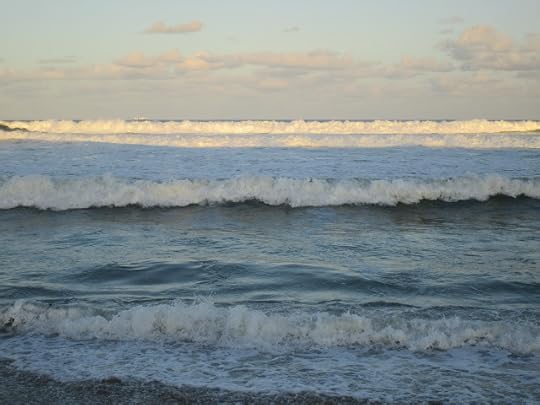

I don't know why for years I avoided all thought of Florida. I think it was snobbery. Florida, I believed, lacked culture. Where would we be without our museums, our theaters, our universities? (In
Florida?) A story I heard years ago summed up this frosty attitude. When a New York City couple retired they said to one another, "Well all our friends have moved to Florida, I guess we should too." So they moved to Florida, settled in, and tried to find some classical music on the radio to listen to. But couldn't seem to find any. "That's it," one spouse said to the other, "we're moving back to New York." Truth is, we spent four days in South Florida last week, and I only tried the radio once. Sure enough, no classical. We settled for 'classic rock' and listened to "The Dancing Queen."
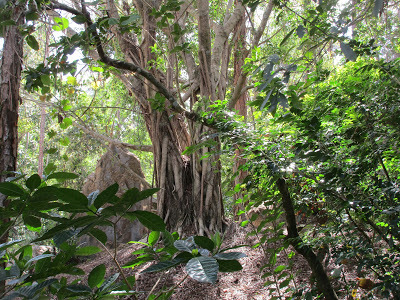 Add your own punch line. It's true that people like us who live in Greater Boston or New York or another urban center enjoy more access to the delights of 'high' culture -- museums, live orchestras, live theater, art shows, opera, author talks -- than the sunny climes of Florida. But if you're not driving to the airport in a rented car to catch a plane home at vacation's end -- a pretty unlovable activity in any time and place -- Florida in March beats the hell out of any place we could be "up north." And after two or three months of the winter drearies, truth is we can live without these spiritual enhancements easier than we can live without sunshine, outdoor exercise, flowers, birds, warm water, and lots of growing green stuff all around and blue sky above.
Add your own punch line. It's true that people like us who live in Greater Boston or New York or another urban center enjoy more access to the delights of 'high' culture -- museums, live orchestras, live theater, art shows, opera, author talks -- than the sunny climes of Florida. But if you're not driving to the airport in a rented car to catch a plane home at vacation's end -- a pretty unlovable activity in any time and place -- Florida in March beats the hell out of any place we could be "up north." And after two or three months of the winter drearies, truth is we can live without these spiritual enhancements easier than we can live without sunshine, outdoor exercise, flowers, birds, warm water, and lots of growing green stuff all around and blue sky above.
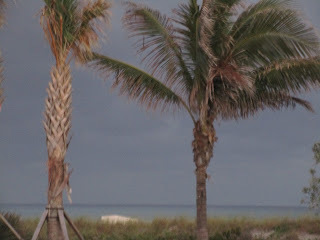 I was wrong about Florida. Particularly in late winter. In the sunny community of Delray Beach, in the first days of March, people as old as me, and older, sit around and talk all day with most of their clothes off. They gather in beach chairs and lounges around the pool, in shade if shade is what they want, in the sun if sun is what they want it (and buy skin screen by the quart). You can have it either way; or a little of both. Sometimes they sit on brightly colored foam floaties manufactured in a bizarre but effective shapes best described by the slang term "noodles" on which they float, in a reclining or even sitting attitude, potentially for hours. This is possible because in Florida they have heated pools outdoors. Sometimes fresh water; sometimes salt water. So if it the temperature isn't quite hot enough for a classic beach day, it's still warm enough to loll by the pool and float around in the warm bath-like water. To avoid any momentarily unpleasant cooling by condensation when you step out of the pool, there's always a transitional visit to the hot tub. On our four-day visit, hard on the heels of the most recent coastal-flooding Northeaster, we ventured beyond our pleasure dome to take in some local delights: An extensive Japanese Garden (the Morikami Museum and Japanese Garden https://morikami.org/) one day. A public boardwalk adventure trail built over wetlands heavily frequented by water-loving fowl (the Green Cay Nature Center and Wetlands, in Boynton Beach) and some slithery creatures prowling underneath, the next. We walked the lovely shores of nearby Delray Beach -- roiled to historically strong surf by the same Northeaster cyclone that drowned New England coasts -- before on the final day jumping into the storm-churned Atlantic. Plus all that pool time. We had meals (and one of us had naps) on a sunny balcony, rubbing shoulders with the green lineaments of invading palms and visited by fat Florida pigeons. For evening repasts we were on the town. Our feats included luscious seafood in a cutting-edge emporium of Nouveau American cuisine; a pub meal in a quaint British-replica establishment with jazz on Sunday nights; and a popular Mexican restaurant with delicious tacos and $3 Margaritas (Monday nights only). Ah, the pleasures of senses. I'm still working on the poems of this season. But I no longer have any difficulty making time -- winter time -- for Florida.
I was wrong about Florida. Particularly in late winter. In the sunny community of Delray Beach, in the first days of March, people as old as me, and older, sit around and talk all day with most of their clothes off. They gather in beach chairs and lounges around the pool, in shade if shade is what they want, in the sun if sun is what they want it (and buy skin screen by the quart). You can have it either way; or a little of both. Sometimes they sit on brightly colored foam floaties manufactured in a bizarre but effective shapes best described by the slang term "noodles" on which they float, in a reclining or even sitting attitude, potentially for hours. This is possible because in Florida they have heated pools outdoors. Sometimes fresh water; sometimes salt water. So if it the temperature isn't quite hot enough for a classic beach day, it's still warm enough to loll by the pool and float around in the warm bath-like water. To avoid any momentarily unpleasant cooling by condensation when you step out of the pool, there's always a transitional visit to the hot tub. On our four-day visit, hard on the heels of the most recent coastal-flooding Northeaster, we ventured beyond our pleasure dome to take in some local delights: An extensive Japanese Garden (the Morikami Museum and Japanese Garden https://morikami.org/) one day. A public boardwalk adventure trail built over wetlands heavily frequented by water-loving fowl (the Green Cay Nature Center and Wetlands, in Boynton Beach) and some slithery creatures prowling underneath, the next. We walked the lovely shores of nearby Delray Beach -- roiled to historically strong surf by the same Northeaster cyclone that drowned New England coasts -- before on the final day jumping into the storm-churned Atlantic. Plus all that pool time. We had meals (and one of us had naps) on a sunny balcony, rubbing shoulders with the green lineaments of invading palms and visited by fat Florida pigeons. For evening repasts we were on the town. Our feats included luscious seafood in a cutting-edge emporium of Nouveau American cuisine; a pub meal in a quaint British-replica establishment with jazz on Sunday nights; and a popular Mexican restaurant with delicious tacos and $3 Margaritas (Monday nights only). Ah, the pleasures of senses. I'm still working on the poems of this season. But I no longer have any difficulty making time -- winter time -- for Florida.
Published on March 10, 2018 21:36
March 9, 2018
The Garden of History: "City of Immigrants"
 Too many of us, said Laura Wagner -- though she put the idea more delicately -- have forgotten who are. Wagner, the executive director of the Unitarian-Universalist Mass-Action Network spoke in a conference room at the Thomas Crane Library in Quincy in front of a mural that depicted Quincy's history and industries under the legend "City of Immigrants.
Too many of us, said Laura Wagner -- though she put the idea more delicately -- have forgotten who are. Wagner, the executive director of the Unitarian-Universalist Mass-Action Network spoke in a conference room at the Thomas Crane Library in Quincy in front of a mural that depicted Quincy's history and industries under the legend "City of Immigrants. "Migrants,' or immigrants, have always been with us, Wagner said. They come -- or are brought -- when we need their labor. Indentured servants arrived even before the Pilgrims. They were brought to the Jamestown, Virginia, to serve a colony of fortune-hunters while they waited for the rumored gold to turn up. Given malaria, bad food, and poor relations with their native neighbors, the mortality rate was strikingly high in Jamestown. Slaves were brought from Africa to provide labor in labor-intensive industries such as tobacco, indigo and, especially, cotton growing. Irish labor built the famed Erie canal, and other 19th century public works such as the railroads that connected cities and towns in the Eastern part of the country.
The demand for labor on the vast transcontinental railroads drove companies to recruit Chinese men (women were generally barred). After the railroads were built, the federal government passed the "Chinese Exclusion Act," one of our country's first immigration laws. In the 19th and early 20th century, Mexican labor was recruited for agricultural work in western states such as California. Later, when the Great Depression created massive unemployment, Mexicans and many US citizens of Mexican descent were deported to a country where they had never lived. And today, of course, immigrants work in many industries, including construction, agriculture, factories, restaurants and hospitality -- generally in jobs where the work is hard and the pay poor. The common theme in the history of American immigration policy, Wagner said, is "racism." Until the mid-20th century legal entry was limited to people who were "considered to be white." Who was white, and who wasn't, was an ongoing discussion until relatively modern times. Wagner spoke at a program on the state's proposed Safe Communities Act, along with the bill's chief legislative proponent,Senator Jamie Eldridge. The law, Eldridge said, is intended to protect the safety and well-being of Massachusetts communities and residents, including undocumented people, by setting reasonable limits on the state's police departments' cooperation with federal cops known as ICE. The proposed law calls for local authorities to refuse to detain immigrants at the request of ICE unless they have been accused of committing a serious crime. Driving offenses, for example, the most common way the undocumented run afoul of American law, would not result in local detention and likely federal deportation.
Eldridge pointed out that a "detainer" from ICE is not a judicial order. It's a request. "Every undocumented person is a target for ICE," Eldridge said. "I believe the police should focus on serious crimes." The Safe Communities Act responds to what Eldridge termed a "period of mass deportation" initiated by the Trump administration. The bill also forbids creation of a "Muslim registry," one of the racist schemes Trump promoted during his shameful campaign of pandering to racist stereotypes. The bill has been endorsed by the state's two police chief organizations because if immigrants, including the undocumented, are afraid they will be deported by people in uniform, they will avoid all dealings with local and state police. This makes good policing much harder. If immigrants believe local or state police are working hand in glove with ICE, Eldridge said, "it's going to create a chilling effect on not only that particular immigrant, but on the whole community. ... They're going to be afraid to interact with police and provide them with information about a crime going on in the community." Undocumented people, in particular, are less willing to report domestic or other forms of abuse if they think their residency status will be challenged. They're less likely to take a sick child -- or an adult family member -- to a hospital, or even a doctor. Or show up for a parents' conference at school. They're less likely to complain if they're being cheated or mistreated at work. Or by a landlord. The same worry makes them more likely to drive away from a motor vehicle accident. And less likely to appear in court if called as a witness or for any other reason. Police chiefs sought an amendment, agreed to by the bill's sponsors, to give police the option to hold people requested for detainment by ICE for up to six hours if the individual has a record for conviction of a serious offense, or if a detainee is under arrest for a terrorism offense. The bill also requires law enforcement to inform anyone detained by ICE that they have the right to hire an attorney to defend him.
Eldridge's bottom line message to Massachusetts residents is to contact the two legislative heads who make things happen (or not happen) in the state legislature, House Speaker Robert DeLeo, Robert.DeLeo@mahouse.gov, and Senate President Harriette Chandler, Harriette.Chandler@masenate.gov, to urge them to bring the bill to a vote. They should also contact their own representatives in the House and Senate to urge them to back the bill. Few South Shore members are among the bill's sponsors, Eldridge said. Unfortunately, we live in timid times.
Published on March 09, 2018 14:16
February 26, 2018
The Garden of History: A Nation of Immigrants With a Knack for Forgetting

The American Paradox: A nation of immigrants with a shameful history of hating and opposing successive "new immigrant" groups that arrive on our shores or cross our borders in conspicuous numbers.
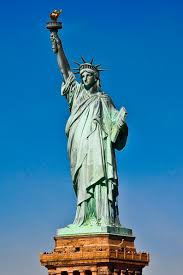 The United States of America was formed from 13 Atlantic Coast English colonies; at one point proud British empire-builders were referring to their country as 'the Atlantic nation.' That British Empire genesis means that English-speakers enjoyed in-group status from the get-go when a country called the 'United States of America' was being invented. English speakers weren't the only national group on the Colonial ground before independence. Those colonies included Dutch, Swedes, French and plenty of Germans and Scots (the last group inclusively 'British' since the merging of England and Scotland in the early 17th century) in addition to those with English ancestry, People of Northern European, Protestant backgrounds were largely accepted by the English-speaking majority of the new country, while other nationalities, even if they were European, faced antagonism, prejudice and a significant hazing period before they were accepted as American citizens like the rest of 'us.' This proved especially true for immigrants who came in large numbers, such as the Irish, Italians, Eastern European Jews and other nationals from all the other countries of Southern and Eastern Europe. English, Scandinavian, German, and the so-called Protestant Scotch-Irish immigrants continued to find acceptance in 19th century America. If, however, you were Catholic (or Jewish) and did not speak English, the doors to social acceptance were barred. It took a lot of battering, over decades, or generations, to force a way in. The concept that best accounts for the degree of acceptance or rejection newcomers faced in America generally goes by the name "race," a word that has no scientific definition. Scholars refer to race as "socio-political" construct. And while the US is hardly the only country to reject and 'otherize' some group of people on racial grounds, the United States defined itself from its beginning as a "white" nation. After a new form of government embodied in the US Constitution was adopted by the independent American 'states' in 1789, the first law to address the concept of citizenship, The Naturalization Act of 1790, defined those eligible to become citizens as "free white persons" of "good moral character." The concept of 'white,' those who study its history tell us, was created to distinguish an 'us' from the 'black' peoples encountered in Europe's age of exploration, colonization, and -- of particular importance to the US -- slavery. When 'white' Americans resisted Irish immigration (the first large influx of Roman Catholics) in the first half of the 19th century, the pejorative stereotypes used on the Irish were borrowed from those already abroad. As Noel Ignatiev explains in his intriguingly titled book, "How the Irish Became White" the "drunk and belligerent foolish Pat and Bridget were stock characters on the American stage" in the pre-Civil War period. The memes of this type -- "happy, lazy, stupid, with a gift for music and dance" -- were clearly borrowed from from the racist typography applied to the African-Americans brought to this country in chains. To which anti-Irish prejudice added drunkenness and criminality. While Irish immigrants worked their way into the fabric of the American mainstream -- building churches, schools, laboring on the country's ever-expanding infrastructure, claiming space in the big cities, electing councilors and mayors -- a new major challenge to the definition of whiteness was posed by the heightened stream of immigrants from Southern and Eastern Europe drawn to the promise of work in American factories following the Civil War. Writing on the large wave of Italian immigration during this period author author Ed Falco states, "America has a proud tradition as an immigrant nation, but it also has a long history of marginalizing those it marks as 'other.'" That darker heritage "includes suspicion, hostility, abuse and even death, leveled against ethnic groups as they arrived one after another in waves over the past 2½ centuries." Falco focuses on an egregious example in which Italian nationals living in the US were treated to an American custom widely bestowed on black Americans: lynching. "...(T)he largest mass lynching in U.S. history took place in New Orleans in 1891 — and it wasn't African-Americans who were lynched, as many of us might assume. It was Italian-Americans." Eleven men were dragged from a New Orelans jail and lynched, after a court found them not guilty of killing the city's mayor. As shameful as the act was, Falco writes, the reaction of 'white America' made it worse. The victims were described by news sources in racist terms as "sneaking and cowardly Sicilians, the descendants of bandits and assassins." The crime was praised by Theodore Roosevelt as "a rather good thing." The New York Times opined that "Lynch law was the only course open to the people of New Orleans." The lynch mob's leader was later elected governor of Louisiana on an openly racist platform. Italians, he said, were "just a little worse than the Negro, being if anything filthier in [their] habits, lawless, and treacherous." What Falco calls "marginalizing," and I'm calling "otherizing," is hardly uniquely American, but it has been a prominent feature of America's 'socio-political' history. Other examples include widespread prejudice against Jewish immigrants in the early 20th century and the similarly 'race'-based antipathy to immigrants from Southern and Eastern Europe such as Poles, Russians, Greeks, Serbs, and Turks during the same period. This is the kind of racially driven "otherizing" we to see today when, for example, an irresponsible politician such as the current occupant of the White House refers to Mexicans as criminals and "rapists." And when the same racist seeks to exclude all residents from a number of Muslim-majority countries from traveling to America -- even as students, valued employees, and eminent scholars -- because they're likely to be terrorists. Long ago, as a college freshman, my American History discussion group considered the institution of African slavery and wrestled with a scholarly theory that different races find it impossible to live together without absolute institutional boundaries. I don't believe that theory any more now than I did then; and I don't believe that "racial" characteristics make some national groups especially difficult to integrate into American society -- as the makers of restrictive immigration laws have argued whenever Americans have taken to scapegoating minorities for fundamental problems such as economic injustice. But I do believe that our history shows certain groups have had to pay a steeper price for acceptance into the mainstream by the recognized 'white' in-group than others. Maybe if we learn this history better than we have in the past, we can avoid repeating it.
The United States of America was formed from 13 Atlantic Coast English colonies; at one point proud British empire-builders were referring to their country as 'the Atlantic nation.' That British Empire genesis means that English-speakers enjoyed in-group status from the get-go when a country called the 'United States of America' was being invented. English speakers weren't the only national group on the Colonial ground before independence. Those colonies included Dutch, Swedes, French and plenty of Germans and Scots (the last group inclusively 'British' since the merging of England and Scotland in the early 17th century) in addition to those with English ancestry, People of Northern European, Protestant backgrounds were largely accepted by the English-speaking majority of the new country, while other nationalities, even if they were European, faced antagonism, prejudice and a significant hazing period before they were accepted as American citizens like the rest of 'us.' This proved especially true for immigrants who came in large numbers, such as the Irish, Italians, Eastern European Jews and other nationals from all the other countries of Southern and Eastern Europe. English, Scandinavian, German, and the so-called Protestant Scotch-Irish immigrants continued to find acceptance in 19th century America. If, however, you were Catholic (or Jewish) and did not speak English, the doors to social acceptance were barred. It took a lot of battering, over decades, or generations, to force a way in. The concept that best accounts for the degree of acceptance or rejection newcomers faced in America generally goes by the name "race," a word that has no scientific definition. Scholars refer to race as "socio-political" construct. And while the US is hardly the only country to reject and 'otherize' some group of people on racial grounds, the United States defined itself from its beginning as a "white" nation. After a new form of government embodied in the US Constitution was adopted by the independent American 'states' in 1789, the first law to address the concept of citizenship, The Naturalization Act of 1790, defined those eligible to become citizens as "free white persons" of "good moral character." The concept of 'white,' those who study its history tell us, was created to distinguish an 'us' from the 'black' peoples encountered in Europe's age of exploration, colonization, and -- of particular importance to the US -- slavery. When 'white' Americans resisted Irish immigration (the first large influx of Roman Catholics) in the first half of the 19th century, the pejorative stereotypes used on the Irish were borrowed from those already abroad. As Noel Ignatiev explains in his intriguingly titled book, "How the Irish Became White" the "drunk and belligerent foolish Pat and Bridget were stock characters on the American stage" in the pre-Civil War period. The memes of this type -- "happy, lazy, stupid, with a gift for music and dance" -- were clearly borrowed from from the racist typography applied to the African-Americans brought to this country in chains. To which anti-Irish prejudice added drunkenness and criminality. While Irish immigrants worked their way into the fabric of the American mainstream -- building churches, schools, laboring on the country's ever-expanding infrastructure, claiming space in the big cities, electing councilors and mayors -- a new major challenge to the definition of whiteness was posed by the heightened stream of immigrants from Southern and Eastern Europe drawn to the promise of work in American factories following the Civil War. Writing on the large wave of Italian immigration during this period author author Ed Falco states, "America has a proud tradition as an immigrant nation, but it also has a long history of marginalizing those it marks as 'other.'" That darker heritage "includes suspicion, hostility, abuse and even death, leveled against ethnic groups as they arrived one after another in waves over the past 2½ centuries." Falco focuses on an egregious example in which Italian nationals living in the US were treated to an American custom widely bestowed on black Americans: lynching. "...(T)he largest mass lynching in U.S. history took place in New Orleans in 1891 — and it wasn't African-Americans who were lynched, as many of us might assume. It was Italian-Americans." Eleven men were dragged from a New Orelans jail and lynched, after a court found them not guilty of killing the city's mayor. As shameful as the act was, Falco writes, the reaction of 'white America' made it worse. The victims were described by news sources in racist terms as "sneaking and cowardly Sicilians, the descendants of bandits and assassins." The crime was praised by Theodore Roosevelt as "a rather good thing." The New York Times opined that "Lynch law was the only course open to the people of New Orleans." The lynch mob's leader was later elected governor of Louisiana on an openly racist platform. Italians, he said, were "just a little worse than the Negro, being if anything filthier in [their] habits, lawless, and treacherous." What Falco calls "marginalizing," and I'm calling "otherizing," is hardly uniquely American, but it has been a prominent feature of America's 'socio-political' history. Other examples include widespread prejudice against Jewish immigrants in the early 20th century and the similarly 'race'-based antipathy to immigrants from Southern and Eastern Europe such as Poles, Russians, Greeks, Serbs, and Turks during the same period. This is the kind of racially driven "otherizing" we to see today when, for example, an irresponsible politician such as the current occupant of the White House refers to Mexicans as criminals and "rapists." And when the same racist seeks to exclude all residents from a number of Muslim-majority countries from traveling to America -- even as students, valued employees, and eminent scholars -- because they're likely to be terrorists. Long ago, as a college freshman, my American History discussion group considered the institution of African slavery and wrestled with a scholarly theory that different races find it impossible to live together without absolute institutional boundaries. I don't believe that theory any more now than I did then; and I don't believe that "racial" characteristics make some national groups especially difficult to integrate into American society -- as the makers of restrictive immigration laws have argued whenever Americans have taken to scapegoating minorities for fundamental problems such as economic injustice. But I do believe that our history shows certain groups have had to pay a steeper price for acceptance into the mainstream by the recognized 'white' in-group than others. Maybe if we learn this history better than we have in the past, we can avoid repeating it.
Published on February 26, 2018 20:28



